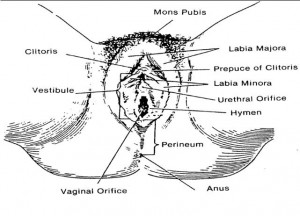The external organs of the female reproductive system include the mons pubis, labia majora, labia minora, vestibule, perineum, and the Bartholin’s glands.
As a group, these structures that surround the openings of the urethra and vagina compose the vulva, from the Latin word meaning covering. See Figure 1-6.
a. Mons Pubis.
This is the fatty rounded area overlying the symphysis pubis and covered with thick coarse hair.
b. Labia Majora.
The labia majora run posteriorly from the mons pubis. They are the 2 elongated hair covered skin folds. They enclose and protect other external reproductive organs.

c. Labia Minora.
The labia minora are 2 smaller folds enclosed by the labia majora. They protect the opening of the vagina and urethra.
d. Vestibule.
The vestibule consists of the clitoris, urethral meatus, and the vaginal introitus.
(1) The clitoris is a short erectile organ at the top of the vaginal vestibule whose function is sexual excitation.
(2) The urethral meatus is the mouth or opening of the urethra. The urethra is a small tubular structure that drains urine from the bladder.
(3) The vaginal introitus is the vaginal entrance.
e. Perineum.
This is the skin covered muscular area between the vaginal opening (introitus) and the anus. It aids in constricting the urinary, vaginal, and anal opening. It also helps support the pelvic contents.
f. Bartholin’s Glands (Vulvovaginal or Vestibular Glands).
The Bartholin’s glands lie on either side of the vaginal opening. They produce a mucoid substance, which provides lubrication for intercourse.
